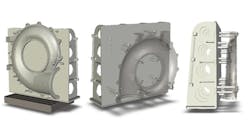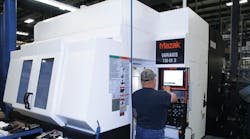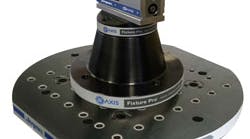Weir Minerals North America, in Madison, Wis., manufactures large pumps for mining slurry applications. It needed a series of very large (108x108 in.) Class 40 iron castings machined for its pump housing fabrication, including milling, drilling and boring. Each pump housing consists of a frame and cover section, and each required an A and B load — which meant four set-ups for a complete housing assembly.
The slurry pumps are used in Canada’s Athabasca tar sand fields, specifically for flue-gas desulfurization (FGD) in the process of extracting oil from the mineral sands.
Weir Minerals presented its problem to Advanced Machine & Engineering Co. (AME), among several other contract manufacturers, to do the machining on these parts, approximately 2-3 sets per week. Each housing section weighed well more than 5,000 lb., presenting substantial challenges for fixturing: rigidity was essential, but other critical considerations was the vibrational distortion from the enormous load and tooling masses involved in the milling, etc.
Although AME started the job and began delivering the machined FGD pump sets on time, by using non-dedicated fixturing, set-up was taking far too long per part — which as AME v.p.-operations Steve Schubert explained, resulted in much higher costs per pump set. Changeover took as long as six to eight hours, each time. Locating and clamping the pump housings was tedious, too, and the methods used raised safety concerns, both in materials handling, strapping and clamp positioning.
Furthermore, clamping forces for the machining process were less than optimal, which had a negative effect on the manufacturing cycle time and the tool life. AME recognized it needed to reduce the total set-up and machining time significantly, as well as improve operator safety.
“The challenge was to design a fixture that was within the weight limitations of our machine tool table,” Schubert detailed, “without compromising the structural integrity and rigidity of the fixture itself.” Too light a fixture would yield poor finishes, with out-of-tolerance dimensions, etc.
“We also needed a design that would allow for quick change of the workpiece,” he indicated, as we did not have a two-pallet machine. So, clever swing clamps were designed to ‘get out of the way’ so we could remove the completed part and put a new one on.
“Finally, but most important of all, we were extremely concerned with safety,” Schubert said. “We needed a fixture that would allow safe usage for the operator to climb onto repeatedly, as well as being secure enough to not allow one of these massive parts to fall off of the table.”
The solution to this challenge was a single, dedicated AMROK® fixture measuring 120x110 in. (WxH) to hold each GFD pump section for both A and B loads. It reduced set-up times to less than 50% of the previous method.
Design advantages
The pump housing is a precision design that requires precision in the production process. Among the details of the pump housing, AME identified
Back pull out design — Using a minimal number of larger-diameter fasteners makes it possible for all rotating and wearing components, including the mechanical seal, to be inspected without disturbing the suction or discharge pipework.
Modular design bearing cartridge — Thisdetail makes it simple to remove the entire assembly for maintenance in a clean environment. A split-release collar fitted on bearing side of the shaft sleeve makes removing the impeller fast and simple.
Long wear life— Specifically designed to handle abrasive and corrosive conditions found in FGD applications, the GSL design makes the most of Weir Minerals' long experience in solids pumping and FGD.
Lower corrosion in impellers — Specially developed in Weir Minerals' material technology laboratories, the high-chromium iron components combined with optimal impeller vane designs minimize wear in pumps.
No corrosion in liners — Natural rubber liners are corrosion-proof versus acidic limestone / gypsum slurries, avoiding corrosion risks that can plague metal-lined pumps, particularly when low-pH slurries are left in the pumps when not operating.
Long bearing and mechanical seal life — Large-diameter, very stiff shaft and short impeller overhand minimizes shaft deflection, providing excellent conditions for the mechanical seal. Fully protected, oversized heavy-duty oil lubricated roller and taper roller bearings carry all the radical and thrust loads with unusually high service factors.
Increasing output
Due to the improvements AME made in the locating and clamping methods, milling and drilling operations were optimized, resulting in a 45% reduction in the overall machining cycle time per pump set.
The critical detail contributing to these substantial savings was the design of the adjustable jacks built into the fixtures, which allowed proper support for the sections during the machining process on a horizontal milling machine.
These savings were shared by AME with Weir Mineral North America. In addition, machining quality and surface finish improved by using only one fixture, instead of multiple, separate fixtures, thus allowing tighter tolerances to be repeated and maintained more easily.
Machine operator safety was enhanced too, due to the standardized lifting, locating, and clamping methods that were employed with this fixture design.
In the end, Weir Mineral North America, was so pleased with the results that they implemented a multiple vendor reduction process and awarded the entire project to AME. Production of these massive GFD pumps improved from three units to five units per day at Weir.








